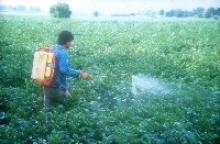Labour-saving technologies and practices: weed wipes and knapsack sprayers
The following technology contains features of weed wipes and knapsack sprayer agricultural tools. It justifies when its utilization might be convenient in terms of its advantages and disadvantages. Advantages include labour-saving, livelihood resilience strengthening, equipment, skills and cost. Disadvantages include skills, cost, risk and infrastructure.
Description
- Weeding by hand using traditional hoes takes 140 hours for one person to weed one hectare. This falls to 65 hours per hectare by the third weeding.
- Weeding is conducted at critical times to avoid the establishment of weeds and crop damage.
- Late weeding of previous crops is done to prevent the setting of seeds.
1. Features of weed wipes
- A small volume of ready-mixed non-selective systemic herbicide (such as glyphosate) is placed in a small container attached to the top of the handle.
- The herbicide is applied through the handle to a broad wick at the bottom of the implement, which is used to wipe the herbicide onto weeds growing in between crop rows.
- Weeds growing close to the crop have to be weeded by hand.
2. Features of knapsack sprayers
- The diluted herbicide is carried in a tank on the operator’s back and is hand pumped under pressure to the distributor with a nozzle to produce a fine spray, which is applied to the weeds.
- These are simple implements but careful operation and maintenance standards must be observed and strict operator safety measures must also be followed.
- Ultra low volume sprayers, using spinning discs to reduce the droplet size, are available. They use concentrated herbicide with less water and so reduce drudgery.
3. Advantages
3.1 Labour saving
- The work rates of knapsack sprayers and weed wipes are much higher than manual weeding: it only takes 12 hours for one person to cover one hectare (approximately ten times quicker).
- Weed wipes are light and minimize drudgery.
3.2 Livelihood resilience strengthening
- Spraying leaves the soil undisturbed.
- The weed roots, still holding the soil together, and weeds on the surface. This improves soil structure and reduces soil erosion potential.
- When weed wipes are used with glyphosate, what little herbicide is left on the topsoil is neutralized by clay particles in the soil.
- Another positive effect for livelihood resilience is that due to the improvement and preservation of soil conditions, crop yield can improve, helping to secure income and food.
3.3 Equipment
- Weed wipes are easy to use with no moving parts and easy to maintain.
- Generally more viable than knapsack sprayers.
3.4 Skills
Weed wipes are relatively safe to use provided the concentrated chemicals are handled carefully when the apparatus is being filled.
3.5 Cost
Weed wipes are generally much cheaper than sprayers and are also cheaper and easier to maintain. Ultra-low volume sprayers use herbicides efficiently.
4. Disadvantages
4.1 Skills
Proper training is essential for the safe use of herbicides and equipment to protect operator health and the environment.
4.2 Cost
The capital cost of knapsack sprayers is relatively expensive and herbicides are expensive. For ultra-low volume sprayers, there is also the capital cost of the spinning discs and the replacement cost of the batteries to power them.
4.3 Risk
Equipment and herbicides can be handled incorrectly. The spray may drift onto the crop plants when using ultra-low volume sprayers.
4.4 Infrastructure
The supply of equipment and herbicides might be constrained.
Figure 1. Knapsack sprayers in use

©FAO/TECA
5. Related/associated technologies
- Jab planter user manual: ID 7339.
- Labour-saving technologies and practices: row planting, hand seeders and planters: ID 7301.
- Labour-saving technologies and practices: seeds and crops: ID 7302.
- Weed management in conservation agriculture: ID 7418.
- Weed management in organic agriculture: ID 8375.
- Labour-saving technologies and practices: improved use of hoes for land preparation, planting and weeding: ID 7296.
- Labour-saving technologies and practices: Draught Animal Power (DAP) planters and weeders: ID 7305.
This technology is also available in Spanish: ID 8692.
6. Objectives fulfilled by the project
6.1 Labour-saving technology (LST)
The technology reduces the time needed to perform weeding; therefore, freeing up the labour for other activities
